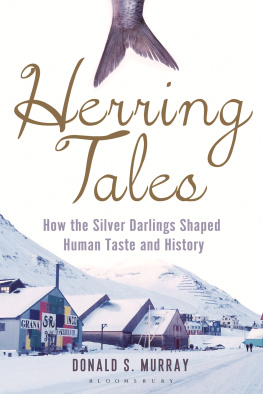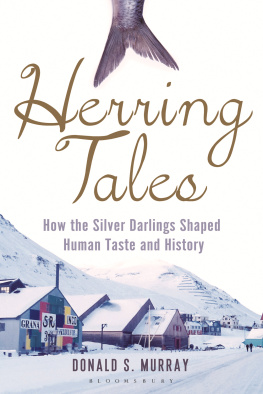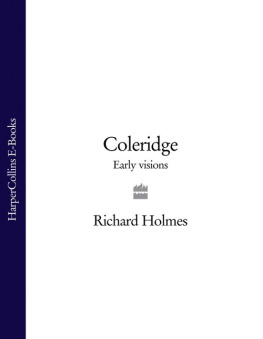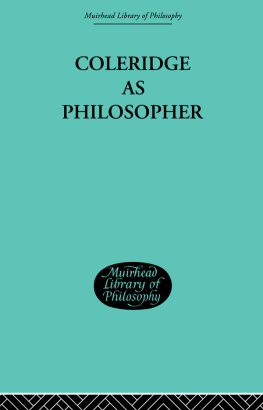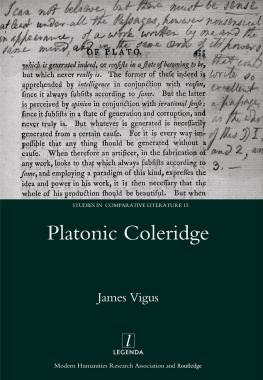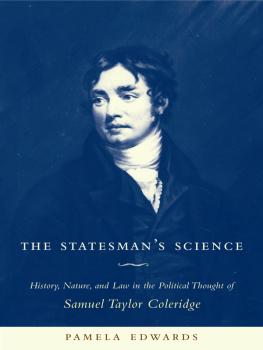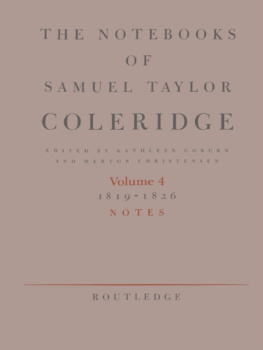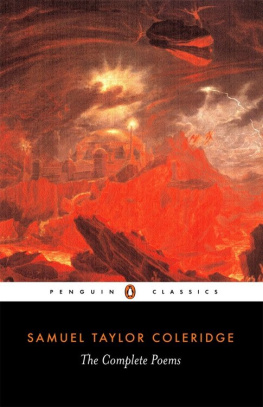TRAGIC COLERIDGE
For Claire
Tragic Coleridge
CHRIS MURRAY
Nanyang Technological University, Singapore
ASHGATE
Chris Murray 2013
All rights reserved. No part of this publication may be reproduced, stored in a retrieval system or transmitted in any form or by any means, electronic, mechanical, photocopying, recording or otherwise without the prior permission of the publisher.
Chris Murray has asserted his right under the Copyright, Designs and Patents Act, 1988, to be identified as the author of this work.
Published by
Ashgate Publishing Limited
Wey Court East
Union Road
Farnham
Surrey, GU9 7PT
England
Ashgate Publishing Company
110 Cherry Street
Suite 3-1
Burlington
VT 05401-3818
USA
www.ashgate.com
British Library Cataloguing in Publication Data
Murray, Chris.
Tragic Coleridge.
1. Coleridge, Samuel Taylor, 17721834. 2. Tragic, The, in literature.
I. Title
828.709-dc23
The Library of Congress has cataloged the printed edition as follows:
Murray, Chris, 1981
Tragic Coleridge / by Chris Murray.
pages cm
Includes bibliographical references and index.
ISBN 978-1-4094-4754-2 (hardcover: alk. paper)ISBN 978-1-4094-4755-9 (ebook)ISBN 978-1-4724-0824-2 (epub)
1. Coleridge, Samuel Taylor, 17721834Criticism and interpretation. 2. Tragic, The, in literature. 3. Disasters in literature. I. Title.
PR4487.T7M87 2013
821.7dc23
2013004324
ISBN 9781409447542 (hbk)
ISBN 9781409447559 (ebk - PDF)
ISBN 9781472408242 (ebk - ePUB)
Contents
Acknowledgements
My academic career began under the cloud of expulsion from playschool. The verdict was that I was underperforming. As my father formulated a query as to what level of attainment was required of kindergarten students the teacher bustled us out the door with the conclusion that He wont be fit for school. Either from faith in my abilities, or horror at the prospect of having me around the house all the time, my parents sent me to school nonetheless. I thank them first, and hope that their persistence was validated; unless a monograph on Coleridge was precisely the outcome the early pedagogue feared.
This book was assisted in part by a Newby Trust Education Grant. Without Michael John Kooys invaluable insights over Twinings Green Tea with Orange & Lotus Flower, this would be a different book. Jonathan Bate gave especially good counsel on Shakespeare and Romantic drama. Warwicks Humanities Research Centre and the CAPITAL Centre funded my conference on The Romantic Voice, at which RSC alumni Judith Phillips and Roger Hyams organised a workshop on Coleridge and Voice. Sorcha Gunne, Michael Hulse, Jacqueline Labbe, Peter Larkin, Emma Mason, Jon Mee and Pablo Mukherjee have all encouraged my research in various ways, while Seamus Perry has proved a sagacious advisor.
At Bristol, Tim Webb has been a steadfast ally in the coffee mornings we have enjoyed since my time on the MA in Romanticism. I am grateful to Andrew Bennett, Stephen Cheeke, Nick Groom, David Punter and Adam Rounce, former tutors at the Centre for Romantic Studies who assisted me with aspects of my work on Coleridge. My MA classmate Ant Howell remains a valuable friend through metaphysical thick and thin. Thanks also to Duncan Kennedy, Neville Morley and Ellen OGorman for welcoming me into the Classics department and Bristols Trinity Mafia.
In the wider field of Romantic studies I am indebted to Jim Mays on several counts. Richard Gravil and Nicholas Roe have kindly invited me to contribute to major conferences and journals. Hence early versions of in Romanticism. David Fairer and Fintan OToole helped with queries on Sheridan, Joyce Crick on German drama, and Peter Swaab on Sara Coleridge. The Charles Lamb Society contributed bursaries to help me attend the Cannington Coleridge Conference and the Wordsworth Summer Conference. Among diverse forms of support for my work, The Friends of Coleridge assisted my attendance of the Kilve Study Weekend, under the direction of Headmaster Graham Davidson, the excellent Paul Cheshire and Peter Larkin (again).
I completed work on this book as a postdoctoral fellow at Nanyang Technogical University, which has been an ideal environment for my scholarship. Thanks to Alan Chan, Terence Dawson, K.K. Luke and Neil Murphy for this opportunity. At Ashgate, my editor Ann Donahue helped the publishing process run smoothly, and my anonymous reader offered very useful feedback on the manuscript.
Abbreviations
CL | The Collected Letters of Samuel Taylor Coleridge, ed. by Earl Leslie Griggs, 6 vols (Oxford: Oxford University Press, 19561971) |
CN | The Notebooks of Samuel Taylor Coleridge, ed. by Kathleen Coburn, M.Christensen and A.J. Harding, 5 vols in 2 Parts: Text and Notes (London: Routledge and Kegan Paul, 19572002) |
In The Collected Works of Samuel Taylor Coleridge, general ed. Kathleen Coburn, Bollingen Series, 75, 16 vols (New Jersey and London: Princeton University Press, 19692001):
BL | Biographia Literaria or Biographical Sketches of My Literary Life and Opinions, ed. by James Engell and W. Jackson Bate, 2 vols (1983) |
CM | Marginalia, ed. by George Whalley and H.J. Jackson, 6 vols (19802001) |
EoT | Essays on his Times, ed. by David V. Erdman, 3 vols (1978) |
Friend | The Friend, ed. by Barbara E. Rooke, 2 vols (1969) |
Lects 1795 | Lectures 1795: On Politics and Religion, ed. by Lewis Patton and Peter Mann (1971) |
LoL | Lectures 18081819: On Literature, ed. by R.A. Foakes, 2 vols (1987) |
LS | Lay Sermons, ed. by R.J. White (1972) |
OM | Opus Maximum, ed. by Thomas McFarland (2002) |
PW | Poetical Works, ed. by J.C.C. Mays, 3 vols (2001) |
SWF | Shorter Works and Fragments, ed. by H.J. Jackson and J.R. de J. Jackson, 2 vols (1995) |
TT | Table Talk, ed. by Carl Woodring, 2 vols (1990) |
Watchman | The Watchman, ed. by Lewis Patton (1970) |
Introduction:
Romantic Tragedy and Tragic Romanticism
In an 1808 lecture Coleridge muses on the destruction of the tragic hero. He explains that the hero is sacrificed to Dionysus, the god representative of the energies of the Universe, that work by passion and Joy without apparent distinct consciousnessand rather as the cause or condition of skill and contrivance, than the result. When there is imbalance between these forces there is discord. Catastrophe follows, in which the hero is annihilated. For the tragedian to witness these conflicting energies evokes Coleridges description of the storm in King Lear:
Its ear-cleaving Thunder Claps, its meteoric splendors [], the contagion & fearful sympathies of Nature, the Fates the Furies, the frenzied Elements dance in and out, now breaking thro and scattering, now hand in hand, with the fierce or fantastic group of Human Passions, Crimes and Anguishes, reeling in a wild harmony to the Swell and Sink of the Earthquake.
Next page

